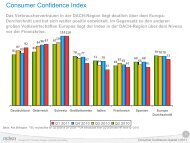You also want an ePaper? Increase the reach of your titles
YUMPU automatically turns print PDFs into web optimized ePapers that Google loves.
Gas Price Hikes continued from page 34<br />
Chart 2: Dollar stores decline, Club &<br />
Supercenters increase<br />
% household shopper penetration<br />
Warehouse<br />
50<br />
50<br />
52<br />
2001<br />
2005<br />
mid-2006<br />
Supercenters*<br />
51<br />
5861<br />
Dollar<br />
Drug<br />
Mass Merch<br />
Grocery<br />
Source: ACNielsen Homescan & Spectra<br />
*Includes Kmart, Target & Wal-Mart Supercenters<br />
59<br />
67<br />
65<br />
86<br />
83<br />
83<br />
95<br />
87<br />
85<br />
100<br />
99<br />
99<br />
Value pricing assumes even more importance in this volatile<br />
climate, and promotions touting at-home family fun nights,<br />
home-cooked family meals and at-home entertaining concepts<br />
accelerate to the front of the strategy options.<br />
Changing habits<br />
Consumers also cited other budget-stretching adjustments to<br />
their shopping and purchasing patterns. Among them are<br />
patronizing supercenters to buy in bulk at lower unit prices,<br />
clipping coupons to capture available savings, and switching<br />
to less expensive grocery brands.<br />
Premium and mid-grade gas patrons downgraded to regular.<br />
Warehouse club stores and Internet shopping options both<br />
benefited from the desire to keep the lid on the gas tank and<br />
spending.<br />
Homefront, workfront<br />
A Florida State University professor explored different<br />
aspects of the fallout from gas prices, discovering that 44%<br />
of the 300 employed consumers surveyed worried about<br />
making ends meet; 41% were paying off debt more slowly<br />
and 25% had gone without basic necessities like food and<br />
heat to conserve funds.<br />
When queried about how changes in their financial picture<br />
affected their job, results were alarming. Respondents cited<br />
negative outcomes across the board, related to more stress<br />
at home. They were less enthusiastic about work and their<br />
employer, less agreeable and helpful to others, less productive,<br />
more sensitive to daily irritants at work and more<br />
depressed overall.<br />
Penetrating insights<br />
Dollar stores, once on a seemingly unstoppable expansion<br />
trajectory, actually experienced a two percent decline in<br />
household penetration, the sole exception among the<br />
“value” channels to lose ground. In a surprising turn<br />
of events, this represents the first decline in dollar store<br />
shopper penetration since we first began tracking the<br />
channel. ■ See chart 2.<br />
This is surprising on the one hand, because gas price<br />
increases that affect those on fixed incomes and with<br />
modest means (the prototypical dollar store shoppers),<br />
might be expected to drive more consumers toward<br />
dollar outlets. It is less surprising in the context of trip<br />
consolidation, where shoppers try to meet all their needs<br />
in the fewest trips possible. The limited food and beverage<br />
assortment and lack of fresh foods at most dollar stores<br />
may be the force behind the decline.<br />
36 Fall/Winter 2006











